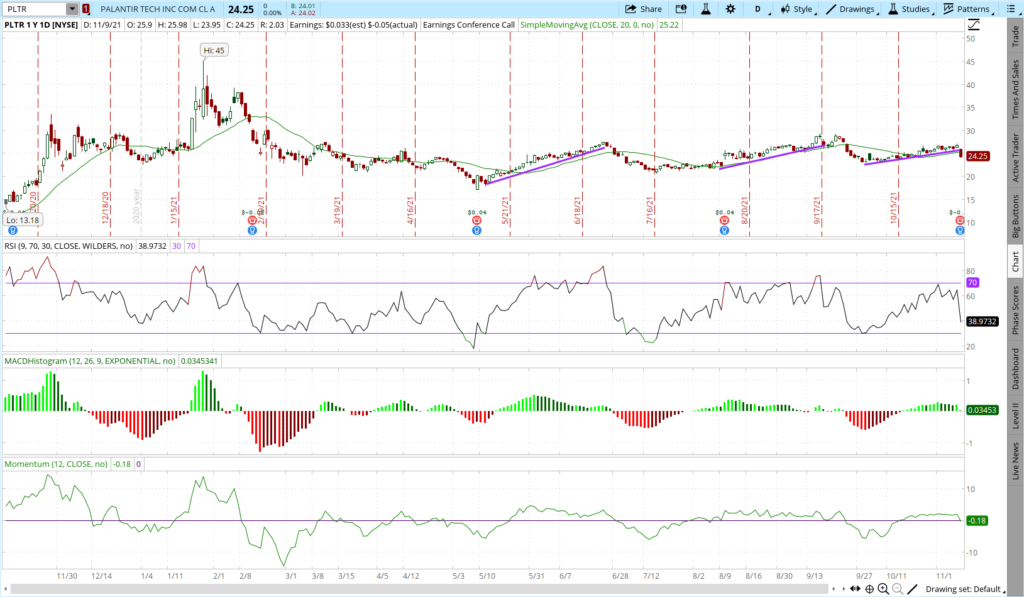This has been a rough year for stocks. Every time the market has tried to bounce, some fresh news has come out, triggering another selloff. With inflation still running hot and the Federal Reserve set for more rate hikes, investors need to be cautious. That said, with the market down this far, there are some great bargains out there. But they aren’t all created equal. In fact, some names that look very cheap are actually stocks to sell.
These seven stocks to sell, in particular, are attracting a lot of attention among traders. With high daily volume and the subject of much discussion on social media, these stocks might seem set for a comeback. But, as you’ll see, each of them comes with major drawbacks. As a result, when you’re bargain hunting, don’t buy these names.
| PLTR | Palantir | $8.03 |
| CCL | Carnival | $8.10 |
| COIN | Coinbase | $63.51 |
| TLRY | Tilray | $3.29 |
| FUBO | FuboTV | $3.74 |
| M | Macy’s | $18.50 |
| DNA | Ginkgo Bioworks | $2.47 |
Palantir (PLTR)

Palantir (NYSE:PLTR) has been shrouded in mystery for some time. The artificial intelligence and security software firm has been in business since 2003. It has extensive ties to the Central Intelligence Agency (CIA) and other national defense agencies. Investors have assumed that its proximity to key power centers would eventually lead to major profits for Palantir.
However, it’s worth questioning when this is going to happen. Palantir will turn 20 years old next year. It’s hardly a young start-up anymore. The company was expected to be one of the top tech unicorns in the 2010s. But it finally limped to market with a poorly received direct stock offering in 2020, as Palantir wasn’t able to convert the buzz into real profits.
PLTR stock surged from $10 to $35 after its direct listing as it got caught up in the meme-stock mania of early 2021. Palantir had a great pitch for the times with its ties to key government agencies and rumors about its big new contracts and deals. As meme stock-mania faded, however, Palantir has fallen below $10 per share.
However, the company still has a market capitalization of more than $15 billion. That equates to a still-high valuation of eight times revenue for a firm that is barely breaking even and whose sales are only growing at around 20% per year. It’s time to stop giving Palantir excuses. Its business has been around long enough that it should have more results than this to justify all the hype.
Carnival Corp (CCL)

Carnival Corp (NYSE:CCL) is one of the three big publicly traded cruise lines. Investors have gravitated to these stocks as a way of playing the great economic and tourism reopening after the pandemic.
That idea made sense for a time. It was plausible that cruise lines would recover along with hotels, restaurants, airlines, and so on. However, fast forward to late 2022, and the thesis no longer holds water.
The cruise lines have repeatedly missed analysts’ average estimates as their revenue and bookings have come up short of expectations. Meanwhile, inflation is wreaking havoc on the supply side of the equation. The prices of labor, fuel, and food have all surged, making it more expensive than ever for the companies to do business.
CCL stock surged this week on hopes related to its new bond offering. It’s true that Carnival is unlikely to go bankrupt anytime soon. However, it faces a heavy debt load and serious dilution from all the shares that it issued to stay afloat during the pandemic. Long story short, Carnival isn’t going out of business, but its shares won’t return to their pre-pandemic levels anytime soon either.
Coinbase Global (COIN)

Coinbase Global (NASDAQ:COIN) is one of America’s leading cryptocurrency exchanges. Last year, that seemed like quite a good business to be in. The price of leading cryptocurrencies were surging, and there was a great deal of excitement about crypto, as celebrities like Matt Damon were promoting it to consumers.
Now, however, crypto is in trouble. Bankruptcies of crypto firms and failing stablecoins have become the new normal. Even the strongest cryptos have slumped amid a bear market for technology in general and blockchain in particular.
Some traders are drawn to COIN stock because of its past earnings. The company earned $17 per share in 2021, which would imply a P/E ratio of four.
That seems great. But the problem is that Coinbase’s earnings are inextricably tied to the price of cryptos because Coinbase charges fees based on a percentage of the value of transactions. When crypto prices slump, so does Coinbase’s earnings.
Now, in fact, Coinbase is expected to lose more than $6 per share in 2022. Analysts, on average, expect the company to lose money in 2023 and 2024. In other words, a big comeback for COIN stock won’t occur unless and until the cryptocurrency market comes back to life.
Tilray Brands (TLRY)

The Biden administration recently announced an executive order regarding cannabis. President Joe Biden is pardoning everyone convicted by the federal judiciary for marijuana possession. Additionally, he has ordered the government to look into changing the status of marijuana as an illegal drug as far as federal regulators are concerned. That action could reduce the severity of the government’s restrictions of cannabis and the punishments for its use.
But such a move by Biden would not legalize cannabis. While it would be a step in the right direction for the cannabis industry, it would be more of a gesture than a tangible development. Right now, American cannabis producers are held back by two main factors: High taxation and a lack of access to traditional banking channels. This Biden administration’s move won’t help solve either problem.
Canadian marijuana firm Tilray Brands (NASDAQ:TLRY) popped more than 30% on the announcement, though it has subsequently given back much of those gains.
But there was little reason for Tilray to rally at all. Tilray is primarily involved in the Canadian market, so federal legalization in the United States — which, to reiterate, hasn’t happened yet — wouldn’t change the game for Tilray. Importantly, the firm continues to report operating losses, limited revenue growth, and has only modest exposure to the U.S. market. In other words, don’t buy TLRY stock as a play on potential U.S. marijuana legalization.
FuboTV (FUBO)

FuboTV (NYSE:FUBO) was supposed to revolutionize sports television. Many FUBO bulls also believed that FuboTV would also become a major player in the sports betting market as well. However, little of the company’s original vision has come to pass, and the shares are off by around 90% from their highs.
Some traders might be drawn to Fubo because 26% of its shares are being sold short, creating the potential for a short squeeze. A squeeze could lead to a short-term jump by the stock price. Over the longer term, however, there’s very little evidence that FuboTV’s business model works. That’s why it’s on this list of stocks to sell.
FuboTV is simply spending so much on content that its subscriber revenues aren’t covering its costs. Buying the rights to live sporting events rights, after all, is expensive.
The company recently announced its preliminary Q3 results, including an adjusted EBITDA loss of around $100 million. That simply isn’t going to cut it. With the company’s cash balance being around $300 million, it could run out of funds by this time next year. On top of that, FuboTV is shuttering its sports betting operations. FuboTV may have an engaging product, but without a better business model, FUBO stock will keep on sliding.
Macy’s (M)

The shares of mall retailer Macy’s (NYSE:M) have rallied off their lows in recent weeks. Traders are looking at M stock as a potential bargain because the shares are trading at around five times the analysts’ average estimate of the company’s earnings.
The issue, however, is that its earnings may come in below the mean outlook. Macy’s and other department stores had a great 2021 as consumers spent at a record pace. But given high inflation, high gas prices, and souring employment prospects, consumers may be more thrifty this holiday season. Meanwhile, higher labor and product costs will put pressure on Macy’s profit margins.
The company is also spending heavily on its share buyback program. That could pay off in a big way if the company can maintain its current profitability. As we saw with the decline of Sears and JC Penney, however, old-school retailers can easily fail if anything goes wrong.
Macy’s may wish it kept that cash on its balance sheet instead of spending it on buybacks. Macy’s may work out, but it’s a risky bet that is far less of a sure thing than its low P/E ratio might suggest.
Ginkgo Bioworks (DNA)

Ginkgo Bioworks (NYSE:DNA) is a synthetic biology company. In English, that means it uses genetic engineering to design organisms which can be utilized for industrial purposes. The company has something of a novel business model, since it designs these genetic compounds and then attempts to sell them to customers across a variety of industries.
This technology has tremendous potential. But hype, along with Cathie Wood’s position in the company, helped lift Gingko to a market capitalization of $20 billion at one point. However, short sellers hit the company with a blistering report suggesting that its technology is far from being commercialized and that many of its deals appear to be made by entities with which it had prior financial relationships. In other words, the technology may not be as wonderful as many believe.
Despite its $2.50 stock price today, Ginkgo still has a market cap of more than $4 billion. That’s an awfully big price tag for a company with around $400 million of annual revenue which is generating large operating losses.
To make matters worse, analysts’ average estimate calls for the company’s revenues to shrink slightly in 2023. so this is an unprofitable firm that isn’t even growing and hasn’t yet validated its business model.
Its technology may eventually enable it to achieve great things. But in this current bear market, more than future possibilities are needed to boost a stock. Ginkgo is a sell; it’s just too risky given current macroeconomic conditions.
On the date of publication, Ian Bezek did not have (either directly or indirectly) any positions in the securities mentioned in this article. The opinions expressed in this article are those of the writer, subject to the InvestorPlace.com Publishing Guidelines.
